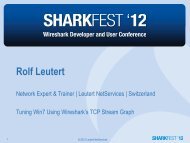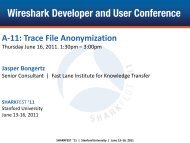VoIP Fundamentals - Sharkfest - Wireshark
VoIP Fundamentals - Sharkfest - Wireshark
VoIP Fundamentals - Sharkfest - Wireshark
Create successful ePaper yourself
Turn your PDF publications into a flip-book with our unique Google optimized e-Paper software.
Phillip D. Shade , Senior Network EngineerMerlion’s Keep Consulting1
Phillip D. Shade (Phill)phill.shade@gmail.com• Phillip D. Shade is the founder of Merlion’s Keep Consulting, aprofessional services company specializing in Network and ForensicsAnalysis• Internationally recognized Network Security and Forensics expert, withover 30 years of experience• Member of FBI InfraGard, Computer Security Institute, the IEEE andVolunteer at the Cyber Warfare Forum Initiative• Numerous certifications including CNX-Ethernet (Certified NetworkExpert), Cisco CCNA, CWNA (Certified Wireless NetworkAdministrator), WildPackets PasTech and WNAX (WildPackets CertifiedNetwork Forensics Analysis Expert)• Certified instructor for a number of advanced Network Trainingacademies including <strong>Wireshark</strong> University, Global Knowledge, SnifferUniversity, and Planet-3 Wireless Academy.
Telephony Perceptions Through the Years….
<strong>VoIP</strong> / Video Protocol StackH.245H.323 SpecificationH.225Call Control & Signalling SDP / SIPQ.931 RASSCCPUnistemMGCPRTCPMedia Codec -G.711, G.729H.261, H.263RTPTCPIPv4 / IPv6UDPData Link Layer Protocol
<strong>VoIP</strong> Protocols Overview (In-band Signaling)• MGCP - Media Gateway Control Protocol– Defined by the IETF and ITU and used to control signaling and sessionmanagement (also known as H.248 or Megaco)• SCCP - Skinny Client Control Protocol– CISCO proprietary protocol used to communicate between a H.323 Proxy (performing H.225& H.245 signaling) and a Skinny Client (<strong>VoIP</strong> phone)• SIP - Session Initiation Protocol– Defined by the IETF / RFC 2543 / RFC 3261• H.323 – Defines a Suite of ITU designed protocols– H.225, H.245, Q.931, RAS, etc…
<strong>VoIP</strong> Protocols Overview (Data)• RTP - Real Time Protocol– Defined by the IETF / RFC 1889– Provides end-to-end transport functions for applications transmitting real-time data overMulticast or Unicast network services (Audio, video or simulation data)• RTCP - Real Time Control Protocol– Defined by the IETF– Supplements RTP’s data transport to allow monitoring of the data delivery in a mannerscalable to large Multicast networks to provides minimal control and identificationfunctionality• RTSP - Real Time Streaming Protocol– Defined by the IETF / RFC 2326– Enables the controlled delivery of real-time data, such as audio and video; designed towork with established protocols, such as RTP and HTTP
Codecs (Audio / Video Conversion)• CODEC = Compressor / Decompressor or Coder / Decoder or Reader - Providesconversion between Audio/Video signals and data streams at various rates anddelays• Designations conform to the relevant ITU standard– Audio Codecs (G.7xx series)• G.711a / u - PCM Audio 56 and 64 Kbps (Most common business use)• G.722 - 7 Khz Audio at 48, 56 and 64 Kbps• G.723.1 / 2- ACELP Speech at 5.3 Kbps / MPMLQ at 6.3 Kbps• G.726 - ADPCM Speech at 16, 24, 32 and 40 Kbps• G.727 - E-ADPCM Speech at 16, 24, 32 and 40 Kbps• G.728 - LD-CELP Speech at 16 Kbps• G.729 - CS-ACELP Speech at 8 and 13 Kbps (Very common for home use)– Video Codecs (H.2xx series)• H.261 - Video >= 64 Kbps• H.263 / H.264 - Video
Sample <strong>VoIP</strong> Codec Comparison• MOS and R value include Packe8az8on delay + Ji=er buffer delay • Common bandwidth – real bandwidth consump8on: # Payload = 20 bytes/p (40 bytes/s) # Overhead includes 40 bytes of RTP header (20 IP + 8 UDP + 12 RTP)
Competing In-Band Signaling Standards• Several different standards are currently competing for dominance in the<strong>VoIP</strong> field:– H.323 - Developed by the International Telecommunications Union (ITU) and theInternet Engineering Task Force (IETF)– MGCP / Megaco/ H.248 - Developed by CISCO as an alternative to H.323– SIP - Developed by 3Com as an alternative to H.323– SCCP – Cisco Skinny Client Control Protocol – used to communicate betweena H.323 Proxy (performing H.225 & H.245 signaling) and a Skinny Client(<strong>VoIP</strong> phone)– UNISTEM – Proprietary Nortel protocol, developed by as an alternative to H.323
H.323 - Packet-based Multimedia CommunicationsSystems• An umbrella standard defined by the International Telecommunications Union(ITU) and the Internet Engineering Task Force (IETF)• Defines a set of call controls, channel set up and Codec’s for multimedia, packetbasedcommunications systems using IP-based networksH.450.1Supplemental, generic protocol for useunder H.323H.225 Call Signaling / RASH.245 Control messages for the H.323 Terminal(RTP / RTCP)H.235 Security EnhancementsQ.931 Call setup and terminationG.711, G.723.1 G.728H.261, H.263, H.264Audio Codec'sVideo Codec’s
<strong>VoIP</strong> Standard (SIP)• Defined in RFC 2543 and RFC 3261 and by the ITU– Pioneered by 3Com to address weaknesses in H.323• Application layer signaling protocol supporting real time calls and conferences(often involving multiple users) over IP networks– Run over UDP / TCP Port 5060 (default)– Can replace or complement MGCP• SIP provides Session Control and the ability to discover remote users• SDP provides information about the call• MGCP/SGCP Provides Device Control• ASCII text based• Provides a simplified set of response codes• Integrated into many Internet-based technologies such as web, email, anddirectory services such as LDAP and DNS– Extensively used across WANs
MGCP / Megaco <strong>VoIP</strong> Standards• Defined by RFC 2705 / 3015 and the ITU in conjunction with the H.248 standard– Pioneered by CISCO to address weaknesses in H.323• Used between elements of distributed Gateways (defined later) as opposed to theolder, single all-inclusive Gateway device– Extensively used in the LAN environment• Utilizes Media Gateway Control Protocol (MGCP) to control these distributedelements– Often considered a “Master/Slave” protocol
Quality Of Service (QoS) - Overview• Provides a guarantee of bandwidth and availability for requestingapplications– Used to overcome the hostile IP network environment and provide anacceptable Quality of Service• Delay, Jitter, Echo, Congestion, Packet loss and Out of Sequencepackets– Mean Opinion Score (MoS) / R-Factor is sometimes used to determine therequirements for QoS.– Utilized in the <strong>VoIP</strong> environment in one of several methods:• Resource Reservation Protocol (RSVP) defined by IETF• IP Differentiated Services• IEEE 802.1p and IEEE 802.1q
Assessing Voice Quality• Voice Quality can be measured using several criteria1. Delay: As delay increases, callers begin talking over each other, eventually the call will soundlike talking on a “walkie-talkie”. (Over…)2. Jitter: As jitter increases, the gateway becomes unable to correctly order the packets and theconversation will begin to sound choppy (Some devices utilize jitter buffer technology tocompensate)3. Packet Loss: If packet loss is greater than the jitter buffer, the caller will hear dead air spaceand the call will sound choppy (Gateways are designed to conceal minor packet loss )High quality voiceconnections require allthree to be minimized
Different <strong>VoIP</strong> Quality Measurement Terms• MoS – Mean Opinion Score - Numerical measure of the quality of human speech atthe destination end of the circuit• PSQM (ITU P.861)/PSQM+ - Perceptual Speech Quality Measure• PESQ (ITU P.862) – Perceptual Evaluation of Speech Quality• PAMS (British Telecom) Perceptual Analysis Measurement System• The E-Model (ITU G.107) – (R-Factor) - Send a signal through the network, andmeasure the other end!
Measures of Voice QualityE-‐Model “R” Factor scores comparison to MOS score • MOS can only be measured by humans• R-value can be calculated in software• PMOS values can be determined from R-value
MOS (Mean Opinion Score)MOSQuality Rating5 Excellent4 Good3 Fair2 Poor1 BadMOS -‐ Mean Opinion Score -‐ Numerical measure of the quality of human speech at the des8na8on end of the circuit (affected extensively by Ji=er) -‐ Uses subjec8ve tests (opinionated scores) that are mathema8cally averaged to obtain a quan8ta8ve indicator of the system performance -‐ Ra8ng of 5.0 is considered perfect
E-Model (R-Factor)• The E-Model - Recommendation ITU G.107– The "E-Model" is a parameter based algorithm based on subjective test resultsof auditory tests done in the past compared with current “system parameters”– Provides a prediction of the expected quality, as perceived by the user– The result of the E-Model calculation is “E-Model Rating R” (0 - 100) which can betransformed to “Predicted MOS (PMOS)” (1 – 5; 5 is non-extended, noncompressed)• Typical range for R factors is 50-94 for narrowband telephony and 50-100 for wideband telephonyCascade Pilot Computes the R-‐Factor and MOS scores
Cascade Pilot – Quality MetricsAverage / Maximum Jitter / Delta and Average / Maximum R-Factor / MOS
Making the Call - Basic <strong>VoIP</strong> Signal FlowGateKeeper / Call Client Manager Endpoint #1 Signaling<strong>VoIP</strong> ProtocolEndpoint #2 MediaTeardown
Expected SIP Operation• To initiate a session– Caller sends a request to a callee's address in the form of a ASCII text command• “Invite”– Gatekeeper/Gateway attempts phnoe number -> IP mapping/resolution• Trying / Response code = 100• Ringing / response code = 180– Callee responds with an acceptance or rejection of the invitation• “Accept” / response code=200 “OK”– Call process is often mediated by a proxy server or a redirect server for routingpurposes• To terminate a session– Either side issues a quit command in ASCII text form• “Bye”
Session Initiation Protocol (SIP - Invite)SIP “Invite” SIP is data is carried in text format
Session Initiation Protocol (SIP - Bye)SIP -‐ “Bye”
Challenges of <strong>VoIP</strong>• Minimize Delay, Jitter and data loss– Excessive Delay variations can lead to unacceptable data lost or distortion• Implementing QoS– RSVP designed to reserve required resources for <strong>VoIP</strong> traffic• Interoperability of equipment beyond the Intranet– Different vendors Gateways utilize different Codec’s• Compatibility with the PSTN– Seamless integration required to support services such as smart card and 800 service
Factors Affecting Delay and <strong>VoIP</strong> Quality - 1• Latency– Round trip latency is the key factor in a call having an “interactive feel”– 10% (non-consecutive packets) will be perceived as a bad connection
Factors Affecting Delay and <strong>VoIP</strong> Quality - 2• Codec Choice - Higher quality = added delay– Greater the compression factors result in lowered quality - Processing / Encoding /Decoding• Bandwidth Utilization - Less utilization = lower latency, jitter and loss due tocollisions• Priority - Voice is extremely sensitive to delay– QoS is used to allow network devices to handle <strong>VoIP</strong> ahead of other traffic
Voice Quality & Delay8007006005004003002001000Delay(msec)Fax RelayBroadcastQualitySatelliteQualityHighQualityDelay TargetMany factors that contribute to theoverall delay are fixed:-Codec delay- Hardware delay- Processing delay- Network physical delayHowever, several delay factors arevariable:- Queuing delay- Network propagation delayIt is the sum of all of these factorsthat determines overall delay asshown in the chart to the left
<strong>VoIP</strong> Delay Calculation ExampleEnd-to-End Delay Not to Exceed 250msIP or WANNetworkFixedDelaysCompression20msInter-process10msTransmission.25 @ T17ms @ 56kNetwork (FR)20-40msTransmission.25 @ T17ms @ 56kInter-process10msDecompression10msBufferConfigurableVariableDelaysQueuing10-20msVariable Network Delay:Private IP: determinableInternet 50-400+msTotal Fixed Delays (w/o buffer) 71-129ms
User Symptoms• Customer Reported Symptoms– Cannot place or receive calls– Hear foreign voices not supposed to be on call (Cross-Talk)– Volume noticeably low or high– Choppy Audio– Features do not work properly• Equipment Alarm Indications– Ring Pre-trip Test Fails– Internal indications (card, power, etc)– Loss of Signal / High Error Rate– Connectivity failures
Analysis of Telephony Protocols - <strong>Wireshark</strong><strong>Wireshark</strong> has the ability to reconstruct not only <strong>VoIP</strong> conversations, but also other mediastreams for later analysis.
Packet Capture FileThis example contains four (4) calls and is from a <strong>VoIP</strong> network using Cisco phones andSIP signaling with G.711 audio codec
<strong>VoIP</strong> Call Detection, Analysis and Playback
















